|
|

|
YAMUNOTRI - GANGOTRI RIDE
Uttranchal, also called "Abode of Gods", abounds in
places of sanctity. Every year thousands of devotees visit the
state by braving the challenges that the mountainous region
offers, treading the arduous trails and hence reinforcing the
triumph of the faith over adversity.
The Plan
We undertook a picturesque pilgrimage in the hinterlands of
Himalayas on June 12, 2003. To make it adventurous we planned
it to be a Mobike Safari. I got hold of a few road-maps, scoured
the net for information on the 'Char Dham Yatra' and charted
our itinerary for the journey. We packed some warm and some
comfortable clothings, rain-gear, slippers, toilet-essentials,
camera & rolls, napkins, driving licence, papers of Bullet,
etc. The biggest mistake that we did was not to carry two spare
tubes to save us from a flat tyre.
Top^
The Man, The Woman & The Machine
Myself & my wife Vandana, we have a 1989 Model Standard
350cc Royal Enfield Bullet having 6V electrical system, with
luggage accessories (carrier stand on both sides and back),
high but straight - bar handle and a military leg-guard.
Top^
The Kick-Off
As we set-off for a package of both an adventurous and spiritual
experience, our hearts were pounding for we had absolutely no
idea of what is in store for us. We were as much excited for
the journey ahead as we were curious to know what riding a loaded
Bullet two-up will be like. As we left NH-58, we embarked on
a bumpy road to Saharanpur. The road ended on a slanted T-point
at which we took a right turn towards Dehradun. Then we headed
straight for Dehradun. Reward of braving the bad road to Saharanpur
was that we reached Dehradun about 30 minutes early with a less
distance covered in comparison to continuing on NH-58 to reach
Haridwar and then from there proceeding to Dehradun. In Dehradun
we got changed the chain and both sprockets (front and rear).
Then we reached Mussoorie after an hour's not-so-steep climb
and moved to Yamuna Bridge via Kempty Falls (KF). Falls are
small but very popular amongst the tourists. There was literally
a jam as it took us full twenty minutes to cross the KF stretch
and that too, imagine, on a bike! The place is mostly thronged
by honeymooners :-) As we proceeded further, we saw three more,
absolutely deserted, similar falls. One of them, we saw, was
used as a flour mill!
Top^
First Night Halt
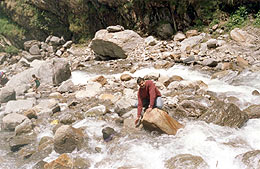 We
finally took a night-halt at Nowgaon. This is a pilgrim route
and all the small townships dotting the way offer accommodation
which is good for one night halt and food with mostly north-indian
cuisine. We were particularly interested in the security of
our mobike so we chose a motel-type of guest-house and booked
a double-bed room for Rs. 200/night. Food in a 'dhaba' nearby
was tasty. We both are vegetarians but even otherwise, the 'dhabawallah'
informed us that it is difficult to find non-vegetarian food
during yatra period. Boozing is also out of question. By the
way, we are teetotalers :-) In the night we looked towards the
star-studded sky - impossible to view in delhi. The river Yamuna
was roaring down in the valley and we could hear the flow hundreds
of feet up at our hotel. Driving of about 400 kms, which includes
more than 135 kms on hill road, on the very first day of our
journey made us dreary so we called it a day. We
finally took a night-halt at Nowgaon. This is a pilgrim route
and all the small townships dotting the way offer accommodation
which is good for one night halt and food with mostly north-indian
cuisine. We were particularly interested in the security of
our mobike so we chose a motel-type of guest-house and booked
a double-bed room for Rs. 200/night. Food in a 'dhaba' nearby
was tasty. We both are vegetarians but even otherwise, the 'dhabawallah'
informed us that it is difficult to find non-vegetarian food
during yatra period. Boozing is also out of question. By the
way, we are teetotalers :-) In the night we looked towards the
star-studded sky - impossible to view in delhi. The river Yamuna
was roaring down in the valley and we could hear the flow hundreds
of feet up at our hotel. Driving of about 400 kms, which includes
more than 135 kms on hill road, on the very first day of our
journey made us dreary so we called it a day.
Top^
Janakichatti (JC) Route
We started early morning and via Barkot, Ranachatti & Sayanachatti
reached Hanumanchatti (HC). View is picturesque throughout from
Mussoorie. From Yamuna bridge the road follows the course of
river Yamuna. Even in night that we spent at Nowgaon, we could
hear the roar of river water-flow hundreds of feet up at our
hotel room. Despite its beauty and a recommended one by the
Uttranchal Government for visiting Yamunotri shrine, this route
is not preferred by pilgrims who mainly visit the Yamunotri
Shrine by following the Haridwar-Rishikesh-Narendarnagar-Chamba-Tehri-Dharasu
route. We guess convenience and familiarity with Haridwar as
the main reason for adopting the Haridwar route. This route
merges with our route (Mussoorie-Yamuna Bridge) at an uneven
turn & a check-post little ahead of Barkot. HC is the final
point for all the pilgrims & travellers who come by HTVs/MTVs
like bus, truck, etc. A very small township sprungs-up there
during the season. But there are no good or very basic accommodation
facilities. There is no tar road then onwards, however a jeepable
road with very steep and dangerous turns is there on which only
cars & jeeps ply. We thought and thought and thought. Fight
between heart and mind is invariably won by heart and we moved
on - the man, the woman & the machine. It was no road for
faint-hearted. One had to really struggle to negotiate the turns
with the bike skidding only on rounded pebbles and mud. It often
rains there and you can well understand the situation then.
But mostly jeeps (99% Mahindra Brands) were found to be plying
on this route and drivers were quite comfortable or at least
they seemed to be.
Top^
The Bang-I
As soon as we reached Phoolchatti, the rear tyre went flat.
It had a deep cut. I got the puncture repaired by coming all
the way back to Ranachatti by jeep. Got back and then we reached
JC. JC is hardly 10 minutes drive from Phoolchatti and has two
manned parking spaces on a small plateau. We parked the thumper
there and proceeded to search for the accommodation.
Top^
Second Night Halt
JC is seemingly a more permanent inhabitation but the residents
are mostly oblivious of the yatra crowd. They don't mingle with
or even care to do so. However, JC is the most suitable place
to stay for night as the accommodation facilities are really
good and cater to all sorts of basic needs. Communication facilities
are missing though as only one hotel has a telephone and that
too is personal. Therefore, once you cross HC, you are severed
from rest of the world as so far (12-12-2003) no cellular network
works there. Water & electricity is not a big problem though,
with electricity cuts only occasional and mostly to avoid electrocution
due to heavy rains. Yes! It rains here almost daily in the afternoon
period. We took a basic but comfortable room for Rs. 200/night
and had food in the same hotel. The food quality was good. It
was a moon-lit night and all the surrounding hills appeared
as if standing at guard to protect us. Vandana was very tired
so she chose to be rather on bed while I proceeded for a very
short hike on the way to shrine just to have a look at the snow
on the Banderpoonch massif. After walking around 100 steps,
snow was visible. With the chill of the night, it was lovely
to see the snow reflecting the moonlight. The roar of the flow
of river Yamuna was the integral part of night's silence at
JC. Thinking of next day's trek, I returned to hotel and we
retired for the day.
Top^
The Yamunotri Shrine
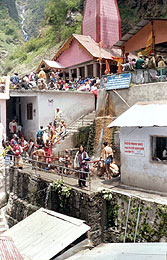 Next
day early in the morning, we started our trek for Yamunotri
alongwith hundreds of other pilgrims. The route to the shrine
is not good. Mud, pebbles, in some stretches unevenly arranged
stone pieces and the mule-shit are all that you will be treading
throughout. In some stretches it is good also but they are very
few. Apart from its poor state, this 5 km hike is seemingly
a never-ending journey. Consider this - you gain a height of
around 747 m and see what? Just in 5 kms! as JC is at 2576 m
and shrine is at 3323 m above sea-level. Appreciable is that
spirit with which even a fifty-year old climbs just to be in
the proximity of what he/she calls the divinity that the source
of river Yamuna is! Truly amazing! Numerous waterfalls can be
spotted on the way which eventually merge with the river Yamuna
as tiny streams. Next
day early in the morning, we started our trek for Yamunotri
alongwith hundreds of other pilgrims. The route to the shrine
is not good. Mud, pebbles, in some stretches unevenly arranged
stone pieces and the mule-shit are all that you will be treading
throughout. In some stretches it is good also but they are very
few. Apart from its poor state, this 5 km hike is seemingly
a never-ending journey. Consider this - you gain a height of
around 747 m and see what? Just in 5 kms! as JC is at 2576 m
and shrine is at 3323 m above sea-level. Appreciable is that
spirit with which even a fifty-year old climbs just to be in
the proximity of what he/she calls the divinity that the source
of river Yamuna is! Truly amazing! Numerous waterfalls can be
spotted on the way which eventually merge with the river Yamuna
as tiny streams.
The whole route is dotted by temporary/makeshift type of tea-shops
which also offer biscuits, bread, etc. This picturesque route
which seems to be engulfed by the high-rising mountains ended
at the Yamunotri Shrine. As we took the last few turns, the
Yamunotri temple was visible from quite a distance which must
be more than a kilometer. The total hike took around 3 hrs.
with medium pace. The temple is small as compared to other three
'dhams' and is at the base of a mountain of Banderpoonch massif,
supposedly. The Yamunotri Shrine is worshipped by hindu devotees
as the source of River Yamuna. Technically speaking, the actual
source is believed to be a frozen lake "Saptarishi Kund"
(SK) of the Champasar Glacier located on the 'Kalind' mountain
at the height of 4421m above sea-level.
As we face the Goddess Yamuna's idol (made of black marble),
on our right flows the freezing waters of river Yamuna coming
from our back. Just beside the temple, there are a few hot-water
springs gushing out of the mountain cavities. The most important
of them is Surya Kund. It is said to be containing medicinal
properties. Pilgrims wrap rice & potatoes in a cloth and
immerse it in the water. We followed the tradition. The water
of the spring boiled-down the contents in a matter of minutes.
This is the Prasad of Yamunotri. The hot water is congregated
at two main tanks which serve the two genders for bathing purposes.
We both took sauna and we bet nothing in life felt that refreshing
ever. It sucked away all our aches. Therefore, if you are there
we recommend the bath. We were very hungry so after 'puja' we
had a little rice from Prasad alongwith Rajma-Rice at a local
restaurant though there is not much choice. The total establishment
at the shrine is not of more than 15 houses.
Accomodation facilities are bare minimum and most pilgrims/travelers
prefer to do up-down from JC. There are two Dharamshalas and
a Garhwal Mandal Vikas Nigam (GMVN) Rest House. The location
of Rest House is good and worth visiting/staying. If you wish
to stay in the GMVN Rest House, advance booking is a must during
season which can easily be done at Rishikesh's GMVN office.
There is way from shrine to Saptarishi Kund (SK) which is technically
the source of Yamuna river. We were confused whether to trek
further to SK or head back and travel to Gangotri. The decision
was made in favour of Bike safari rather than a trekking sojourn
in high himalayas. In any case, the way to SK is said to be
extremely difficult and we were not equipped. We were further
convinced of our wrong thoughts when we asked a local for the
way to SK and he and other overhearing gave us a peeving glance
- "Aap dono!......SK ko jaaooge!". As if they want
to say - Forget it man! Therefore we descended back to JC and
started for Gangotri.
Top^
The Bang-II
It was raining heavily at that time. While taking our bike out
of the parking one jeepwallah did not budge from its place and
finally when it did it banged into my hand brake. The lever
(yoke) was on the ground the very next moment. I controlled
my temper and thought it to be a blessing in disguise as the
road was very slippery due to rain and front brakes may have
increased the risk of a skid. Finally we started with a very
very steady pace and crossed that rough terrain with great difficulty
but without a halt. On such a terrain we were forced to think
why the h**l other three gears are there when only first is
sufficient.
Top^
Picturesque Ride
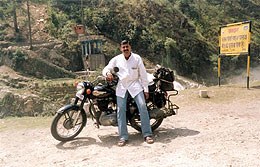 To
reach Uttarkashi, we left our earlier route at barkot checkpost
and picked-up the Gangotri & Haridwar road. This route was
full of scenic beauty. Adding to the glamour were the small
drizzle & the sun was just in the setting mode. We rode
throughout in the pleasant hill evening, smelling the 'Chir'
fragrance all the way. It turned out to be our most enjoyable
ride so far as the road condition was very good and the traffic
was moderate. From a T-point 3 km off Dharasu we took a left
while those who take right go to Rishikesh & Haridwar. To
reach Uttarkashi, we left our earlier route at barkot checkpost
and picked-up the Gangotri & Haridwar road. This route was
full of scenic beauty. Adding to the glamour were the small
drizzle & the sun was just in the setting mode. We rode
throughout in the pleasant hill evening, smelling the 'Chir'
fragrance all the way. It turned out to be our most enjoyable
ride so far as the road condition was very good and the traffic
was moderate. From a T-point 3 km off Dharasu we took a left
while those who take right go to Rishikesh & Haridwar.
Top^
Kashi of Uttranchal
Uttarkashi is a big township comparatively and not inappropriate
if considered a mini city. It derives its name from an ancient
Shiva temple which is located on the right bank of river Bhagirathi
and also in the heart of the city. The town has a Nehru Institute
of Mountaineering which is worth a visit. It has a museum. We
reached there on a holiday - Bad luck! There is a small temple
of 'Kuteti Devi' - a goddess from Kota (Raj.) on a hill-top.
We particularly visited that temple as we have our moorings
in Kota. For mobike repairs, we found Uttarkashi the ideal place
in that region. It had plenty of shops and lot of mechanics.
Though our bike was not giving any problem, I purchased hand-brake
lever from a local shop at a reasonable price. We reached uttarkashi
late in the evening and took our third night halt at Vandana's
aunt's place.
Top^
On the Bhagirathi Trail
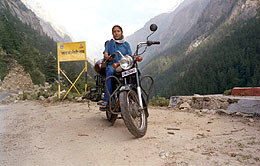 Early
morning we started for Gangotri but I was worried about the
cut in the rear tyre. With god's prayers on our lips we soon
started to Dhug-Dhug-Dhug, the man, the woman and the machine.
As in case of Yamunotri, here also the whole route basically
follows the course of river Bhagirathi, except few detours to
the hill-tops. From Uttarkashi, as we moved further, the view
of the mountains improved and the scenic beauty reached the
climax at Sukhi-Top. From here we had an excellent panoramic
view of the snow-clad Himalayas. Several peaks were visible
but our untrained eyes could not identify any of them. A little
ahead is Harsil, a small township, which is almost a valley
as here the river's both banks are farthest from each other
which can then be seen only at Rishikesh. Full of Deodar trees,
the place is perfect shoot location. Nature's bounty was unfolded
to us. Fortunately, the climax did not end as we moved on to
the shrine with Bhairon Ghati equally beautiful and so is the
shrine itself. We travelled around 100 kms as we touched the
shrine and the road is very good. Parking space is on the main
road before the temple and is less compared to the volume of
vehicles visiting the place daily. Vehicle influx surpasses
the capacity during the noon-time. Fortunately, Bullet doesn't
need sky to get parked. Just to avoid vandalism being practiced
on our bike we parked the vehicle before a Prasad shop and requested
the owner to keep an eye over the vehicle for which he readily
agreed. Early
morning we started for Gangotri but I was worried about the
cut in the rear tyre. With god's prayers on our lips we soon
started to Dhug-Dhug-Dhug, the man, the woman and the machine.
As in case of Yamunotri, here also the whole route basically
follows the course of river Bhagirathi, except few detours to
the hill-tops. From Uttarkashi, as we moved further, the view
of the mountains improved and the scenic beauty reached the
climax at Sukhi-Top. From here we had an excellent panoramic
view of the snow-clad Himalayas. Several peaks were visible
but our untrained eyes could not identify any of them. A little
ahead is Harsil, a small township, which is almost a valley
as here the river's both banks are farthest from each other
which can then be seen only at Rishikesh. Full of Deodar trees,
the place is perfect shoot location. Nature's bounty was unfolded
to us. Fortunately, the climax did not end as we moved on to
the shrine with Bhairon Ghati equally beautiful and so is the
shrine itself. We travelled around 100 kms as we touched the
shrine and the road is very good. Parking space is on the main
road before the temple and is less compared to the volume of
vehicles visiting the place daily. Vehicle influx surpasses
the capacity during the noon-time. Fortunately, Bullet doesn't
need sky to get parked. Just to avoid vandalism being practiced
on our bike we parked the vehicle before a Prasad shop and requested
the owner to keep an eye over the vehicle for which he readily
agreed.
Top^
The Gangotri Shrine
 The
Gangotri temple like Yamunotri temple opens on the auspicious
day of 'Akshaya-tritiya' which falls in the month of April or
May and closes on the day of Diwali which falls in the month
of October or November. The Gangotri temple is a complex of
sanctum sanctorum and few rooms on the periphery. The idol of
Goddess Ganga was covered with flowers & garlands and only
face-part was visible. A few stairs from the temple lead to
the bank of river Bhagirathi. The flow of the river is mighty
terrifying and so is the freezing water. When we saw Bhagirathi
for the first time at 3 km off Dharasu, we could term the river
Yamuna as 'TINY'. The flow of river Yamuna is no match for river
Bhagirathi. At the shrine, the river Bhagirathi is wider and
the basin is boulder-laiden. What? What did you ask? Did I venture
into the icy waters? Forget it, man! No ordinary man can withhold
her flow & freeze for just 30 seconds and that too at the
bank, forget about little towards the middle of the river. Interestingly
nothing can defy religious spirits as people were taking bath
out in the chill. Situated at an elevation of 3100 m above sea-level,
the place becomes very cold as the evening sets in. Warm clothing
is a must. The
Gangotri temple like Yamunotri temple opens on the auspicious
day of 'Akshaya-tritiya' which falls in the month of April or
May and closes on the day of Diwali which falls in the month
of October or November. The Gangotri temple is a complex of
sanctum sanctorum and few rooms on the periphery. The idol of
Goddess Ganga was covered with flowers & garlands and only
face-part was visible. A few stairs from the temple lead to
the bank of river Bhagirathi. The flow of the river is mighty
terrifying and so is the freezing water. When we saw Bhagirathi
for the first time at 3 km off Dharasu, we could term the river
Yamuna as 'TINY'. The flow of river Yamuna is no match for river
Bhagirathi. At the shrine, the river Bhagirathi is wider and
the basin is boulder-laiden. What? What did you ask? Did I venture
into the icy waters? Forget it, man! No ordinary man can withhold
her flow & freeze for just 30 seconds and that too at the
bank, forget about little towards the middle of the river. Interestingly
nothing can defy religious spirits as people were taking bath
out in the chill. Situated at an elevation of 3100 m above sea-level,
the place becomes very cold as the evening sets in. Warm clothing
is a must.
Top^
Excursions We Will Do!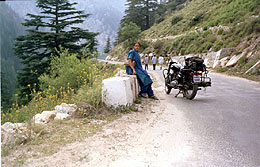
Popular excursions from the Gangotri Shrine are Gaumukh (The
snout of the Gangotri Glacier - the physical source of the holy
Bhagirathi), Tapovan (beautiful meadow that encircle the base
of Shivling peak), Nandanvan (base-camp for Bhagirathi Peaks
and also to have a superb view of Shivling peak) and Kedar Tal
(crystal-clear water with Sphatikling and Thayalasagar peaks
forming a splendid backdrop). But we had no choice as I had
to join back at my office the day after. So after spending around
four hours at the shrine we drove back. While coming back we
took a brief halt at 'Gangnani', a very small township which
seems to be actually there because of hot sulphur springs. I
took bath while Vandana kept watching/snapping me :-)
Top^
The Bang-III - Oh No! Not Again!
Two kilometers short of Uttarkashi the tyre again went flat.
Fortunately it had enough air for me to drive to Uttarkashi.
I left Vandana (a huge risk) at a local shop-cum-hotel as there
was no police station nearby and I was losing air from the tyre.
I drove faster than usual (again a risk) but reached safely
in the uttarkashi township for the tyre shop. This time we placed
a comparatively thicker tyre piece at the place of the cut.
I knew this would increase the risk of skid at the turns but
it was manageable if driven very carefully. We were not at all
ready for another flat tyre. After repair I brought back Vandana
and we took our fourth day's night halt at Uttarkashi town.
Top^
Back to Pavilion!
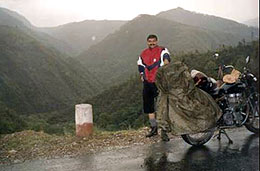 Fifth
day morning we drove-down straight to Delhi while touching Dharasu,
New Tehri, Chamba, Narendranagar and Rishikesh with a brief
halt at Haridwar for a late lunch. When we were at Narendranagar
a full-fledged rain started and forced us to take shelter while
the machine enjoyed the rain alone and loaded. After the clear-sky,
the view from Narendranagar hills of the Himalayan snow-clad
peaks was mesmerizing, reminiscent of what we saw over our heads
only a day before. Fifth
day morning we drove-down straight to Delhi while touching Dharasu,
New Tehri, Chamba, Narendranagar and Rishikesh with a brief
halt at Haridwar for a late lunch. When we were at Narendranagar
a full-fledged rain started and forced us to take shelter while
the machine enjoyed the rain alone and loaded. After the clear-sky,
the view from Narendranagar hills of the Himalayan snow-clad
peaks was mesmerizing, reminiscent of what we saw over our heads
only a day before.
Top^
HAPPY TRAILS
Paraj Shukla |
|